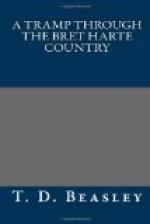Coloma suffered severely from fires. Little of the old town remains but ruins of stone walls, and here and there an isolated wooden building. The ruins, however, are not only exceedingly picturesque, being half buried in foilage of beautiful trees, but hold the imagination with a grip that is indescribable. I could willingly have tarried here for days.
But while old Coloma is dead, there is a new Coloma that furnishes an extraordinary contrast. It is a sweet and peaceful little hamlet, situated on the lower benches of the canon, well up out of the river bottom, and is entirely devoted to horticulture. One has read of birds building their nests in the muzzles of old and disused cannon; even that does not suggest a more anomalous association of ideas than the spectacle of a vine-clad cottage shaded by fig trees, basking peacefully in the sun, so close to what was at one time a veritable maelstrom of human passions. So far as the new Coloma is concerned, Marshall’s discovery might never have been made. Nowhere else will you find a spot where gold and what it stands for would seem to mean so little, Coloma! It is passing strange that a name so sweet and restful should forever be linked with the wildest scramble for gold the world has ever seen!
Chapter V
Auburn to Nevada City Via Colfax and Grass Valley. Ben Taylor and His Home
After surmounting the canon of the South Fork of the American River, you gradually enter a open country, the outskirts of the great deciduous fruit belt in Placer County, which supplies New York and Chicago with choice plums, peaches and pears. About three miles from Auburn, the road plunges into one of the deepest canons of the Sierras, at the bottom of which the Middle and North Forks of the American River unite. Just below the junction, the river is spanned by a long suspension bridge. Auburn is remarkably situated in that one sees nothing of it until the rim of the canon is reached, at least a thousand feet above the river. Thus there are no outskirts and you plunge at once into the business streets, passing the station of the Central Pacific Railway, which line skirts the edge of the canon on a heavy grade.
I had accomplished a good thirty miles but that did not prevent me from accompanying my friend on a long and protracted hunt for comfortable quarters in which to eat and spend the night. There was quite an attractive hotel near the railroad, but actuated by a desire to see something of the town, which we found to be more than usually drawn out, we passed it with lingering regret. Whether by chance or instinct, we drifted to the ruins of the old hotel, now in process of reconstruction, and were comfortably housed in a wooden annex.




